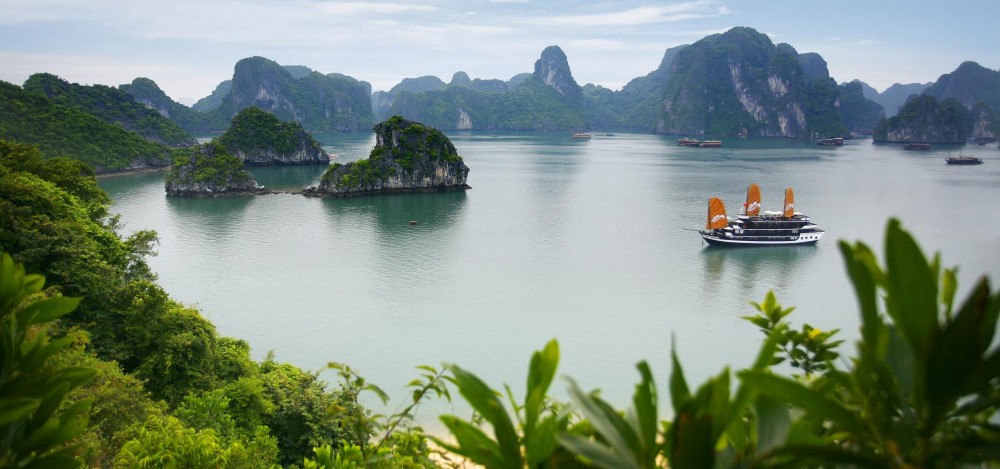Going into our visit to the John McCain Memorial in Hanoi, my classmates and I weren’t sure what purpose a tribute to an American prisoner of war could serve in present day Vietnam. Now, after a few days to think about the monument and to talk to my classmates, its meaning is still unclear to me. We began our last full day in Hanoi with a visit to the Hoa Lo Prison, which was used from 1964 to 1973 to hold American prisoners of war, including John McCain. A section of the museum inside the former prison was dedicated to this period of the building’s history, and McCain’s flight suit and personal effects were featured prominently in the exhibit. There were also two photos of him: one depicted Vietnamese soldiers and civilians removing McCain from the Truc Bach lake, where he fell when his plane was shot down, and the other showed a doctor treating his wounds at the prison.
After finishing our museum visit, we drove to the memorial. The bus stopped at the side of the road by the Truc Bach Lake and we all walked over to the monument. It included a sculpted image of McCain alongside a brief description of his position in the U.S. Navy and how he was shot down while on a mission to bomb a power plant. The image showed McCain with his hands raised, though the meaning of the posture was ambiguous; he could have been falling from his aircraft, being lifted from the lake, or surrendering. In all three scenarios, however, McCain is in a position of weakness in relation to his captors, as well as to the modern Vietnamese state. Particularly given the level of political prominence he assumed in the 1990s and beyond, portraying him as helpless suggests the relative strength of the northern Vietnamese army and their modern-day successors.
While American tourists who have been exposed to John McCain’s accounts of his experiences during the Vietnam War might be interested in seeing the monument, it was certainly not very accessible for foreigners. It is just a small statue on a sidewalk a bit out of the way of many common tourist areas, and the Vietnamese inscription is not translated to English. The Lonely Planet’s Vietnam guidebook includes Truc Bach Lake as a tourist site, but makes no mention of the monument. The memorial was also erected sometime between 1975 and 1985, prior to the reopening of relations between Vietnam and the United States, so it certainly was initially intended for a Vietnamese audience.
McCain began his national political career in the early 1980s, so the monument presumably was designed to celebrate the capture of a “celebrity” POW. A quick Google Image search yielded a bizarre photo of John McCain and other members of an American delegation smiling next to this monument celebrating his own imprisonment – very obviously a photo op intended to represent a renewal of friendship between the United States and Vietnam at the political level. McCain has made highly publicized allegations of severe torture during his time in Hoa Lo Prison in the years since the photo was taken, sparking some controversy and anger in Vietnam.
This complicated relationship between John McCain and Vietnam made visiting the monument today feel all the more strange. Different people can have such different interpretations of it; Vietnamese visitors perhaps see in it a national victory over an occupying power or may feel the sting of McCain’s more recent public remarks, while American tourists – if they even realize what the monument is – may be more likely to recall McCain’s personal wartime accounts or other common American POW narratives. With the opening of relations between the two countries, both at a political level and in terms of rising tourism, the ambiguous message of the memorial seems more and more confused. McCain’s vacillation between supporting reconciliation and accusing his captors of torture, contrasted with the consistent argument in the Hoa Lo Museum that the American prisoners were treated fairly, also complicates the history that the monument represents. Does the monument today and the memories it engenders promote further understanding of the war, or deepen divisions by recalling a point of strong contention between many common Vietnamese and American narratives? Does it have any obligation to address these issues as remembrance of the war changes over time? With so many implications to the various interpretations of the monument, I find it difficult to come to any definitive conclusion about the purpose it serves or the real impact it has. The memorial itself may be physically unassuming and contain a simple narrative of the sequence of events leading to John McCain’s capture, but as with all of the representations of war history we came across in Vietnam, the meanings behind it become infinitely complex.
